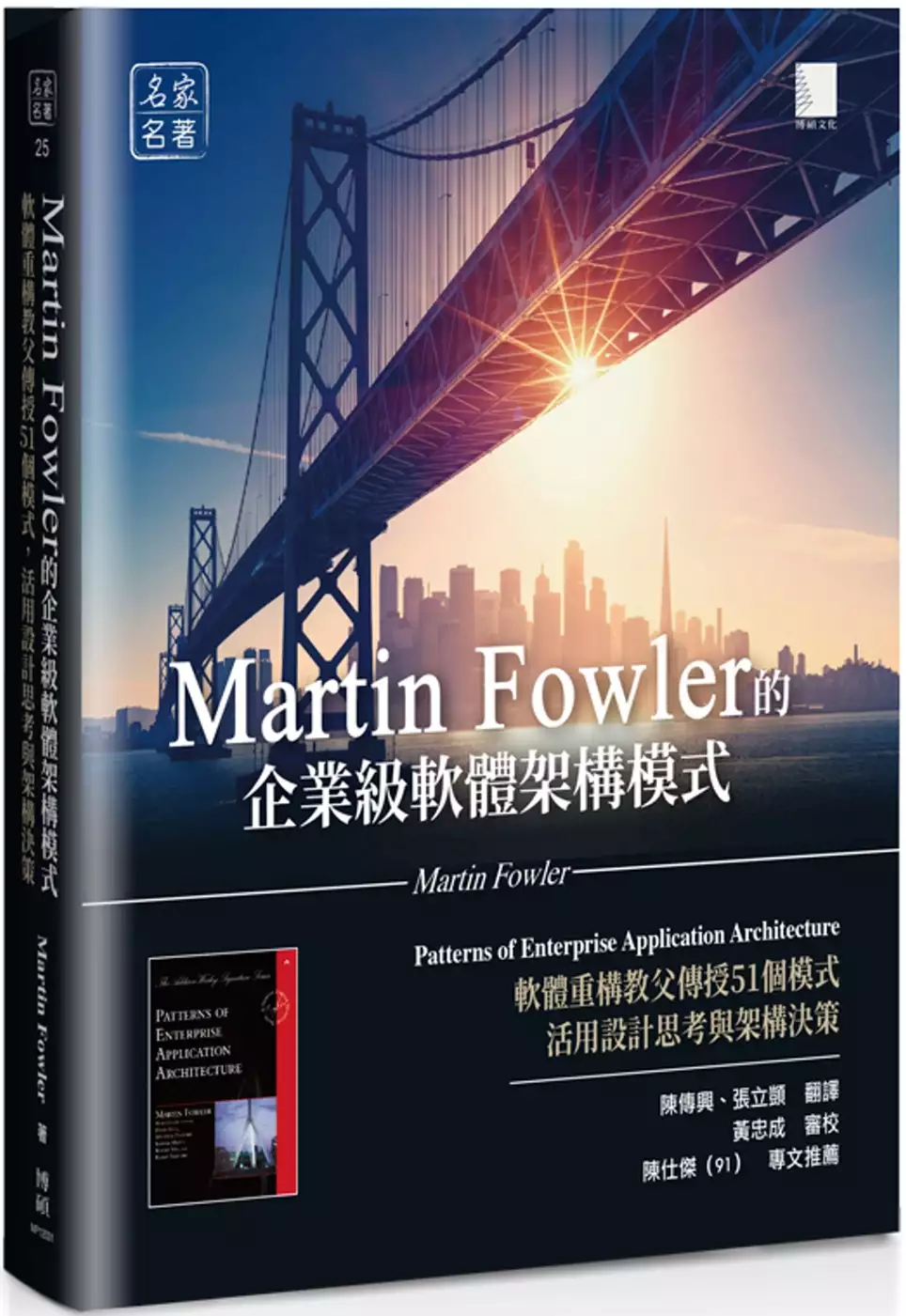c++ template教學的問題,透過圖書和論文來找解法和答案更準確安心。 我們找到下列懶人包和總整理
c++ template教學的問題,我們搜遍了碩博士論文和台灣出版的書籍,推薦MartinFowler寫的 Martin Fowler的企業級軟體架構模式:軟體重構教父傳授51個模式,活用設計思考與架構決策 和陳會安的 超簡單AIoT物聯網與網站架設必學神器:Node-RED視覺化開發工具都 可以從中找到所需的評價。
這兩本書分別來自博碩 和博碩所出版 。
龍華科技大學 資訊網路工程系碩士班 陳永輝所指導 陳建宇的 ADDIE教學設計模型結合人工智慧技術於IP導向範本式作業之輔助批改系統設計與研究 (2021),提出c++ template教學關鍵因素是什麼,來自於輔助批改系統、ADDIE教學設計模型、IP導向範本式作業、人工智慧、預測模型。
而第二篇論文國立清華大學 社會學研究所 古明君所指導 趙慧瑩的 跟上集體的步伐?! ——中國頂尖大學的菁英生產 (2021),提出因為有 中國大學生、菁英研究、主體位置、自傳訪談的重點而找出了 c++ template教學的解答。
Martin Fowler的企業級軟體架構模式:軟體重構教父傳授51個模式,活用設計思考與架構決策

為了解決c++ template教學 的問題,作者MartinFowler 這樣論述:
★★★榮獲素有IT書籍奧斯卡金像獎之稱的第13屆Jolt獎★★★ ✎與一群專家級貢獻者David Rice、Matthew Foemmel、Edward Hieatt、 Robert Mee以及Randy Stafford共同合作,Martin Fowler之必讀經典✎ [名家名著] 25 Martin Fowler的企業級軟體架構模式 Patterns of Enterprise Application Architecture 陳傳興、張立顗 翻譯 黃忠成 審校 陳仕傑(91) 專文推薦 企業級軟體開發的實踐因許多新技術的出現而受惠。物件導向程式語言(如
Java和.NET)與新工具和新技術的日趨普及,讓我們有能力建置更穩固與強健的應用程式,但它們並不容易實作。開發人員在企業級應用程式中總是會面臨相同的困境、遭遇同樣的難題,因為他們尚未充分領會到資深前輩們的架構經驗和失敗教訓。 本書介紹的,正是企業級軟體開發人員所面臨的種種嚴峻挑戰。企業級應用程式(如預約系統、供應鏈程式、金融系統等等)的挑戰是獨特的,與桌上型電腦系統和嵌入式系統同行所面臨的挑戰截然不同。因此,企業級開發人員往往必須自行挖掘解決方案。 本書作者Martin Fowler是全球知名的物件導向大師、軟體重構教父,他發現,儘管技術發生了變化──從Smalltalk到
CORBA,再到Java與.NET──相同的基本設計概念仍然可以調整並應用來解決這些常見的問題。在一群專家級貢獻者的幫助下,Martin將40多種重複出現的解決方案淬鍊成為模式,並提供完整的脈絡,讓讀者能夠在面對困難的設計決策時做出正確的選擇,最終寫成這本不可或缺的解決方案手冊,它適用於任何的企業級軟體平台。 本書實際上是兩本書合二為一。第一個部分是開發企業級應用程式的簡單教學,讀者可以從頭到尾閱讀,以熟悉本書的範圍及章節安排。第二個部分則是本書的主軸,是關於模式本身的參考手冊,Martin為每一個模式都提供了用法和實作資訊,並搭配Java或C#程式碼的詳細範例。書中還利用豐富的UML
圖形來進一步解釋這些概念。 你將從本書學會: ・將企業級應用程式劃分為多個分層 ・組織商業邏輯的主要方法 ・深入處理物件與關聯式資料庫之間的對應 ・使用MVC模式來組織Web的呈現 ・處理跨越多個交易的資料的並行問題 ・設計分散式物件介面 ・來自David Rice、Matthew Foemmel、Edward Hieatt、Robert Mee、Randy Stafford的專家級分享
c++ template教學進入發燒排行的影片
Hello friends! December is finally here! Today we're going to share with you how to make a cutest mini gingerbread houses, it’s also a mug topper.
Christmas is coming. It's so much fun to have with your family to create these cutest mini gingerbread houses. Decorating the gingerbread house can be a great party idea, it's more fun than eating. Especially these tiny gingerbread houses mug toppers, they are adorable.
Making gingerbread dough is super easy. In this video, we’ll show you how to make the best gingerbread dough with fresh ginger to create a natural flavor. Using fresh ginger gives it an intense ginger flavor, and it’s easy to get, too. In addition to the dough recipe, we will also share with you how to easily make royal icing. Are you ready to have fun with us? Enjoy.
This is an #ASMR ver, you can check out the other version that with BGM and Voices in Chinese if you like:
https://youtu.be/f4KKEkmKOsI
---------------------------------------------------------------------------------------------
How to make Mini Gingerbread House Mug Topper Recipe
Mini Gingerbread House Mug Topper Recipe
🎄 Preparation:
➊ A mini gingerbread house template download link: https://drive.google.com/file/d/16UvJW9EbfkjbUShTVKdqI1HlU194e-7c/view
➋ piping bags and nozzles, or make a parchment bag for piping, 2mm is for sticking, 1.5mm is for decoration
🎄 Yields: Can make 14~16 gingerbread houses
✎ Ingredients
🎄 For the cookies
unsalted butter 125g, softened
brown sugar 90g
molasses 58g
egg 1, at room temperature
all purpose flour 370g
baking soda 5g
salt 2.5g
grated ginger 10g
ground cinnamon 1.5g
nutmeg powder 1g
🎄 For the Royal Icing
vanilla extract 1.5g
powdered sugar 200g, sifted
powdered egg white 7.5g
warm water 25g~30g
✎ Instructions
🎄 For the cookies
1. In a large bowl, add butter, sugar and molasses, beat on mid-low speed, mix well until light and smooth.
2. Add egg and ginger, beat on medium speed until well combined. Scrape down the sides and the bottom of the bowl and beat again if needed to combine.
3. Sift the flour, baking soda, ground cinnamon, nutmeg powder and salt.
4. Fold in all dry ingredients, continue to mix until well blended, the dough should come together.
5. Transfer the dough out onto a work surface and knead until the dough is smooth and combined. Wrap the dough with plastic wrap and place in the fridge for 1 hour to chill.
6. Preheat the oven to 170°C.
7. Lightly flour the work surface and roll the dough to about 3mm thick.
8. Dust the dough lightly with flour to avoid sticking. Place the house pattern pieces on the dough, dip the knife into flour and cut out the pattern pieces from the dough (cut the door, but remove it after baking). You will need TWO of each shape.
9. Bake at 170°C for 10 minutes or until the edges are just beginning to brown. Large pieces will need more time.
10. Once baked, cut the door first, and then remove all cookies on racks to cool completely.
🎄 For the royal icing
1. Sieve the 200g of powdered sugar and 7.5g of powdered egg white in a bowl.
2. Add 1.5g of vanilla extract and 25g of warm water and beat at medium speed for 5 minutes.
3. Fill the Pastry Bag With Royal Icing. You will need at least two piping bags, one is for a thick line to glue the pieces of house together. Another one is a thin line to decorate the house. The royal icing is the best icing to use for gingerbread houses, it'll dry hard and last throughout the holiday season.
🎄 Assembling
1. Start with the front and the back pieces and two sides, then take the side piece and stick them together, do the same with the other side.
2. Grab the back piece and give it a nice firm. Then the base of the house is done. Wait for the icing sets before adding the roof.
3. Sticking the roof pieces in the same way, add lines of icing on all the edges, hold them together and allow the icing to set. It's probably best to let this dry overnight that way all the royal icing is definitely hard before decorating.
4. You can decorate with any pattern you like and custom detail. You can practice how to draw a line or draw a pattern on a board or plate before putting them on your house. But remember, once finished the decorating, please let the icing dry for a couple hours. Have fun.
-----------------------------------------------------------------------
Chapters:
00:00 opening
00:32 ingredients
01:28 Making gingerbread dough
04:52 Dividing, rolling and cutting(gingerbread house and gingerbread man)
07:29 Set the oven, let it cool off
08:04 Making Royal icing
09:00 Handmade Piping bag
09:49 Assembling
12:01 Final result
-----------------------------------------------------------------------
* Kevin MacLeod創作的「Deck the Halls」是依據 創用 CC (姓名標示) 4.0 授權使用。 https://creativecommons.org/licenses/by/4.0/
來源: http://incompetech.com/music/royalty-free/index.html?isrc=USUAN1100263
演出者: http://incompetech.com/
ADDIE教學設計模型結合人工智慧技術於IP導向範本式作業之輔助批改系統設計與研究
為了解決c++ template教學 的問題,作者陳建宇 這樣論述:
經實驗分析「IP 導向範本式作業」以每位學生的座號為實驗 IP 的一部分,用以區別實驗結果。同時防止學生拷貝其他同學的作業,而正因為每份作業都是獨一無二,造成批改的工作過於繁鎖,所以為了降低批改的時間,同時提升學習成效,本論文提出了一套系統,採用 ADDIE 教學設計模型的理論,將傳統教學模式與「輔助批改系統」結合並應用神經網路,協助導師在教學的流程上,縮短時間成本以利提升教學品質。一直以來考試成績往往是最能夠證明學生對於課程的理解,但有一個問題,若要總結學生的學習狀況,都是在學期結束之後。為了能夠在學期結束前就預先知曉學生的學習狀況,本論文應用監督式學習法,透過迴歸模型進行學習成效的預測,
以學生的作業成績預測其考試成績,以此來預測學生在下一次的考試狀況,若結果不佳則可即時得知,並且能夠在接下來的施教上加強學生對於課程與考試理解。因此,本實驗在個人電腦上執行的結果顯示,輔助批改系統之執行,平均每份作業批改之耗時可縮短至 20.35 秒,影像辨識在訓練集的部分可以達到 100% 的準確率,預測模型訓練集與測試集的準確率可以分別達到 74.44% 與 64.29%。
超簡單AIoT物聯網與網站架設必學神器:Node-RED視覺化開發工具

為了解決c++ template教學 的問題,作者陳會安 這樣論述:
∗目前已知最簡單的IoT物聯網與Web網站架設工具∗ ∗使用視覺化流程建構工業4.0、智慧製造和智慧工廠∗ ∗輕鬆使用Node-RED建構你自己的物聯網平台與MVC網站∗ Node-RED 可以說是目前已知最簡單的 AIoT 物聯網與 Web 網站架設工具,能夠幫助你快速整合相關應用來建構出監控介面的儀表板(Dashboard),和使用各種網路通訊協定進行資料交換。Node-RED 更支援 MVC 架構的 Web 網站,只需幾個節點的視覺化流程,加上少少的 HTML 標籤和 JavaScript 程式碼,就可以輕鬆建構 MVC 架構的 Web網站、REST API、存取 MySQL
資料庫和打造 AIoT 智慧物聯網平台。 內容重點 ✎零基礎免寫程式輕鬆使用 Node-RED 視覺化流程來建立監控介面的儀表板(Dashboard)、執行網路爬蟲和剖析 Open Data 的 JSON 資料。 ✎使用 Node-RED 輕鬆建構 MVC 架構的 Web 網站、實作 REST API 和將資料存入 MySQL 資料庫。更支援 MQTT、 TCP、 UDP 和 Websocket 通訊協定和序列埠通訊,幫助我們整合 Arduino 和 ESP8266 開發板,最後使用 TensorFlow.js 打造你的 AIoT 智慧物聯網平台。 ✎本書提供 Node
套件的綠化版 Node-RED 開發環境,免安裝輕鬆幫助你建構學習 Node-RED 物聯網應用和 Web 網站架設的 Windows 開發環境。
跟上集體的步伐?! ——中國頂尖大學的菁英生產
為了解決c++ template教學 的問題,作者趙慧瑩 這樣論述:
大學是從學校進入社會的過渡場域,青春則是邁向成年走向獨立的過渡狀態,時間和空間上的雙重過渡使得大學生活面對著意義世界的急劇擴張和最不確定的自我狀態。但作為社會化的一環,大學也必須通過制定標準和層層篩選勾勒出一套關於優秀和成功的清晰畫像,服膺於市場或國家的需要。這使得在大學的主體探尋的過程也必然是與這些主導性的社會力量所製造出來的社會想像範本,相抗衡或協商的過程。我關心的是在中國的教育場域到底生產出什麼樣的菁英?菁英性是如何在不同人的選擇和成長過程裡被界定出來?教育作為階級翻轉的跳板究竟意味著什麼?我將自己的大學歷程作為田野,並對13名不同科系的同學進行了深入的自傳式訪談,並通過不同的自我選擇
和制度性的軌跡,區分出四種不同的主體位置。管理菁英是學校裡的優勝者,但他們並不滿足於學校的選拔邏輯,而是致力於做更多額外的事情,來不斷地量化自己的能力,與市場的要求對齊,證明自己的市場價值。新時代幹部則是與國家的要求最為貼近的一群人,因為在中國的大學中,本就有與公務員系統相接軌的制度性的資本轉換軌道,所以他們往往被認為是最按部就班的一群人。他們只需要遵循著集體的軌跡,就能自然地成為國家的幹部。知識人的主體位置是大學自主性的體現,他們將自己作為抵抗市場和國家幹預的守衛象牙塔的角色。在中國大學特殊的文化氛圍裡,他們也養成了一種文人知識分子的習性。非典型名校生則是沒辦法把自己鑲嵌進任何制度化軌跡的人
,他們拒絕成為菁英,或是想要提出一種不同的菁英形象。他們通過社團的集體抵抗、跨建制的自由聯結或是保持距離,尋找到真實地做一個普通人的種種可能。四種主體位置的畫界與競爭裡,也是市場、國家與大學間不同力量的角逐與合謀,最後在主體的身上呈現出新自由主義、傳統再發明與社會主義遺產之間的奇特拼裝。大家在努力的將自己社會化成一個合格的菁英模樣的過程裡,也湧現出階級的作用、結構的宰製、個人與集體的碰撞,對於中國式的菁英主義的重新再思考。